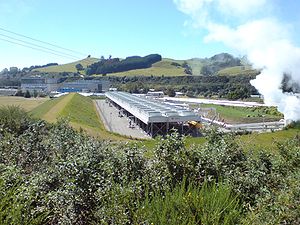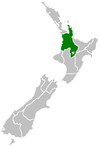Wairakei Power Station
| Wairakei Power Station | |
|---|---|
 The Wairakei Power Station, with the main two blocks at the left rear. The binary plant is in front. | |
 | |
| Country | New Zealand |
| Location | Wairakei, north of Taupō |
| Coordinates | 38°37′37″S 176°06′19″E / 38.62694°S 176.10528°E |
| Status | Operational |
| Commission date | November 1958 |
| Owner(s) | Contact Energy |
| Geothermal power station | |
| Type | Flash steam with binary cycle[1] |
| Wells | 55 production 6 reinjection 50 monitoring[1] |
| Max. well depth | 660 m (2,170 ft)[1] |
| Power generation | |
| Units operational | 6× 11.2 MW 3× 30 MW 1× 4 MW 1×14 MW binary |
| Nameplate capacity | 175 MW |
| Capacity factor | 89.0% |
| Annual net output | 1365 GWh[1] |
| External links | |
| Commons | Related media on Commons |
The Wairakei Power Station is a geothermal power station near the Wairakei Geothermal Field in New Zealand. Wairakei lies in the Taupō Volcanic Zone.
History[edit]
The power station was built in 1958, the first of its type (wet steam) in the world, and it is currently owned and operated by Contact Energy. A binary cycle power plant was constructed in 2005 to use lower-temperature steam that had already gone through the main plant.[2][3] This increased the total capacity of the power station to 181 MW.[1] The Wairakei power station is due to be phased out in 2026, replaced by the Te Mihi geothermal power station.[4] The Poihipi Power Station was built in 1996 at a nearby site in the same field.[2]

Units[edit]
Wairakei A station
- Unit 1 – 11.2 MW intermediate pressure
- Unit 4 – 11.2 MW intermediate pressure
- Unit 7 – 11.2 MW low pressure
- Unit 8 – 11.2 MW low pressure
- Unit 9 – 11.2 MW low pressure
- Unit 10 – 11.2 MW low pressure
Units 2, 3, 5 and 6 were decommissioned in 1984.
Wairakei B station
- Unit 11 – 30 MW intermediate/low pressure
- Unit 12 – 30 MW intermediate/low pressure
- Unit 13 – 30 MW intermediate/low pressure
Wairakei Unit 14 – 4 MW intermediate/low pressure
Wairakei Binary Plant – 14 MW binary
Effects[edit]

The use of steam from the field has had a number of visible effects on the local environment. Visible geothermal activity has increased (due to changes in the water table / water pressure allowing more steam to be created underground, upsurging at places like Craters of the Moon), while there has also been some land subsidence and reduction in steam volumes from the field after some decades of use. Recent total electrical production has been sustained or increased with the investment in additional power stations such as the binary plant of 2005 designed for lower-temperature generation, but the total still does not reach the early power levels such as the 192MW reported in 1965 (NZED Annual Statistics), for instance. Some power stations in the field are now capped in their extraction capacities and a substantial part of the water / steam is being reinjected after use.[2]
The hot geothermal fluid that is extracted is originally cold rainwater that had percolated downwards and been heated by hot rock; pumping back the warm water that emerges from the exhaust of the generator system thus reduces the heat drawn from the ground. The majority of arsenic in the Waikato River comes from the geothermal power station with the concentration reaching 0.035 grams of arsenic per cubic metre in certain places. The amount of arsenic gradually declines as the river flows northwards and is at its lowest at the Waikato River Heads.[5][6]
Transmission[edit]

Also at Wairakei is a major electrical substation, owned by the national grid operator Transpower. The substation is a major switching point for the Central North Island, and is responsible for connecting more than half the country's geothermal power stations, several hydroelectric power stations, the electricity supply to the entire Hawke's Bay and Gisborne regions and half of the Bay of Plenty region. A 33 kV connection at the substation supplies Unison Networks' Taupō distribution network.[7]
See also[edit]
References[edit]
- ^ a b c d e "Geothermal" (PDF). Contact Energy. Archived from the original (PDF) on 2010-06-04. Retrieved 2008-10-23.
- ^ a b c "Geothermal Fields". New Zealand Geothermal Association. Archived from the original on 2013-06-28. Retrieved 13 March 2011.
- ^ "Geothermal Energy and Electricity Generation". New Zealand Geothermal Association. Archived from the original on 2016-01-14. Retrieved 13 March 2011.
- ^ "Contact Energy to replace Taupō geothermal ststions". Radio New Zealand. Retrieved 4 August 2023.
- ^ Arsenic in the New Zealand environment - Brett Robinson, Brent Clothier, Nanthi S. Bolan, Santiago Mahimairaja, Marc Greven, Christopher Moni, Monica Marchetti, Carlo van den Dijssel and Georgina Milne - Institute of Natural Resources, Massey University, Palmerston North, New Zealand
- ^ Inflows of geothermal fluid chemicals to the Waikato River catchment, New Zealand - M.H. Timperley and B.A. Hauser, New Zealand Journal of Marine and Freshwater Research, 1996: Vol 30: 525-535.
- ^ "Chapter 11: Central North Island Regional Plan - Annual Planning Report 2012" (PDF). Transpower New Zealand Limited. March 2012. Retrieved 1 July 2012.
Further reading[edit]
- Martin, John E, ed. (1991). People, Power and Power Stations: Electric Power Generation in New Zealand 1880 - 1990. Wellington: Bridget Williams Books Ltd and Electricity Corporation of New Zealand. pp. 316 pages. ISBN 0-908912-16-1.
External links[edit]
- New Zealand Geothermal Association - Wairakei Power Station information page

